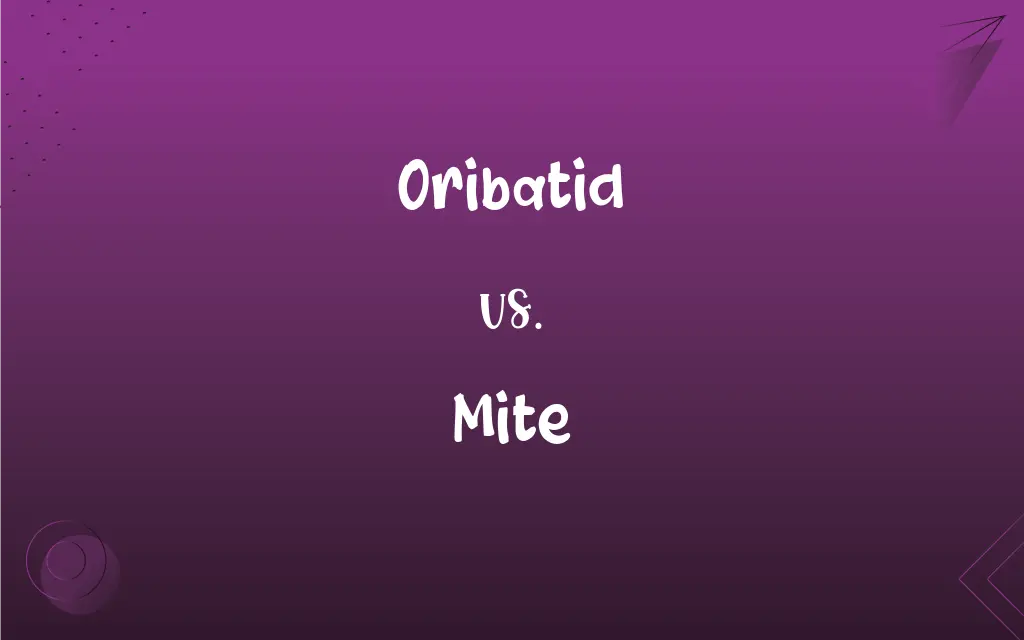Oribatid vs. Mite: What's the Difference?
By Harlon Moss & Janet White || Updated on May 30, 2024
"Oribatid" refers to a specific group of mites known for living in soil and leaf litter, while "Mite" is a broad term encompassing various small arachnids, including oribatids, that inhabit diverse environments.

Key Differences
"Oribatid" mites, also known as beetle mites or moss mites, are a specific subgroup of mites. These tiny arachnids are primarily found in soil, leaf litter, and moss, playing a crucial role in decomposition and nutrient cycling. They are characterized by their slow movement and heavily sclerotized bodies. "Mite" is a general term for a diverse group of arachnids belonging to the subclass Acari. Mites inhabit various environments, from soil and water to plants and animals. This group includes many species, such as dust mites, spider mites, and oribatid mites, each adapted to specific ecological niches.
Oribatid mites are typically non-parasitic and contribute to soil health by breaking down organic matter. In contrast, many other mites, such as dust mites and spider mites, can be parasitic or cause damage to crops and stored products, highlighting the diversity within the mite group.
The ecological roles of oribatid mites are primarily beneficial, as they help in nutrient cycling and soil formation. Other mites, however, can be pests, causing health issues in humans and animals or agricultural damage, illustrating the varying impacts of different mite species.
Oribatid mites have a slow reproductive rate and are generally less of a concern in human contexts, whereas some other mite species reproduce rapidly and can infest homes, plants, and animals, causing significant problems for humans and agriculture.
Comparison Chart
Definition
A subgroup of mites in soil and litter
A broad group of small arachnids
ADVERTISEMENT
Habitat
Soil, leaf litter, moss
Diverse: soil, water, plants, animals
Ecological Role
Decomposers, nutrient cycling
Varies: decomposers, parasites, pests
Movement
Slow
Varies: slow to fast
Impact on Humans
Generally beneficial
Can be beneficial or harmful
Oribatid and Mite Definitions
Oribatid
A subgroup of mites primarily found in soil and leaf litter.
Oribatid mites play a crucial role in decomposing organic matter.
ADVERTISEMENT
Mite
Vary in ecological roles from beneficial to harmful.
While some mites help decompose organic matter, others damage crops.
Oribatid
Contributes to nutrient cycling in ecosystems.
Oribatid mites help break down leaf litter, enriching the soil.
Mite
A small arachnid belonging to the subclass Acari.
Mites can be found in nearly every habitat on Earth.
Oribatid
Also called beetle mites or moss mites.
Beetle mites, or oribatid mites, are common in forest soils.
Mite
Any of numerous small or minute arachnids of the order Acarina, including species that damage crops or stored food and species that are parasitic on animals and often transmit disease.
Oribatid
Known for their heavily sclerotized bodies.
The hard exoskeleton of oribatid mites protects them from predators.
Mite
A very small contribution or amount of money.
Oribatid
Generally non-parasitic and beneficial.
Unlike some mites, oribatid mites are not harmful to crops.
Mite
A widow's mite.
Oribatid
(zoology) Any of a group of mites of the suborder Oribatida
Mite
A very small object, creature, or particle.
Mite
A coin of very small value, especially an obsolete British coin worth half a farthing.
Mite
Any of many minute arachnids which, along with the ticks, comprise subclass Acarina (aka Acari).
Mite
A small coin formerly circulated in England, rated at about a third of a farthing.
Mite
A lepton, a small coin used in Palestine in the time of Christ.
Mite
A small weight; one twentieth of a grain.
Mite
Anything very small; a minute object; a very little quantity or particle.
A mite
Mite
A small or naughty person, or one people take pity on; rascal.
Mite
Eye dialect of might
Mite
A minute arachnid, of the order Acarina, of which there are many species; as, the dust mite, cheese mite, sugar mite, harvest mite, three-toed spider mite, etc. See Acarina.
Mite
A small coin formerly circulated in England, rated at about a third of a farthing. The name is also applied to a small coin used in Palestine in the time of Christ.
Two mites, which make a farthing.
Mite
A small weight; one twentieth of a grain.
Mite
Anything very small; a minute object; a very little quantity or particle.
For in effect they be not worth a myte.
Mite
A slight but appreciable addition;
This dish could use a touch of garlic
Mite
Any of numerous very small to minute arachnids often infesting animals or plants or stored foods
Mite
Includes diverse species like dust mites and spider mites.
Dust mites are common in household environments.
Mite
Can be parasitic or free-living.
Some mites live on plants, while others parasitize animals.
Mite
Often very small and difficult to see with the naked eye.
Many mites are microscopic and require magnification to be observed.
FAQs
Where do oribatid mites live?
They primarily live in soil, leaf litter, and moss.
What are oribatid mites?
Oribatid mites are a subgroup of mites found in soil and leaf litter, known for their role in decomposition.
Are oribatid mites harmful?
Generally, no. They are beneficial decomposers.
Do all mites affect humans?
Not all, but some, like dust mites, can cause allergies.
What is a mite?
A mite is a small arachnid from the subclass Acari, encompassing a wide range of species in various habitats.
Where can mites be found?
Mites can be found in soil, water, on plants, and on animals.
What is the ecological role of oribatid mites?
They help in nutrient cycling and decomposition of organic matter.
Can mites be harmful?
Yes, some mites can be parasitic or cause damage to crops and stored products.
How do other mites reproduce?
Many mites reproduce rapidly, especially pest species.
How do oribatid mites reproduce?
They have a slow reproductive rate compared to other mites.
What is another name for oribatid mites?
They are also called beetle mites or moss mites.
Do oribatid mites affect humans?
Rarely, as they are mostly beneficial and live in soil.
Can oribatid mites be found indoors?
Rarely, as they prefer soil and outdoor environments.
Do other mites cause crop damage?
Yes, spider mites and others can cause significant agricultural damage.
Are oribatid mites easy to see?
They are small but can be seen without a microscope.
Can mites be found indoors?
Yes, species like dust mites are common indoors.
Do oribatid mites cause crop damage?
No, they are generally not harmful to crops.
What is the ecological role of mites in general?
Mites have varied roles, from decomposers to pests.
Are mites easy to see?
Many mites are microscopic and require magnification.
Why are oribatid mites important?
They play a crucial role in maintaining soil health and nutrient cycles.
About Author
Written by
Harlon MossHarlon is a seasoned quality moderator and accomplished content writer for Difference Wiki. An alumnus of the prestigious University of California, he earned his degree in Computer Science. Leveraging his academic background, Harlon brings a meticulous and informed perspective to his work, ensuring content accuracy and excellence.
Co-written by
Janet WhiteJanet White has been an esteemed writer and blogger for Difference Wiki. Holding a Master's degree in Science and Medical Journalism from the prestigious Boston University, she has consistently demonstrated her expertise and passion for her field. When she's not immersed in her work, Janet relishes her time exercising, delving into a good book, and cherishing moments with friends and family.
































































